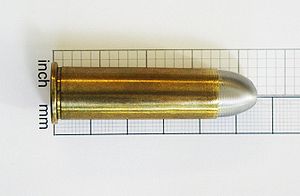50-70
| .50-70 Government | ||||||||||||||||
|---|---|---|---|---|---|---|---|---|---|---|---|---|---|---|---|---|

| ||||||||||||||||
| Type | Rifle | |||||||||||||||
| Place of origin | USA | |||||||||||||||
| Service history | ||||||||||||||||
| In service | 1866-1873 | |||||||||||||||
| Used by | USA | |||||||||||||||
| Production history | ||||||||||||||||
| Designed | 1866 | |||||||||||||||
| Specifications | ||||||||||||||||
| Case type | Rimmed straight | |||||||||||||||
| Bullet diameter | .515 in (13.1 mm) | |||||||||||||||
| Neck diameter | .535 in (13.6 mm) | |||||||||||||||
| Base diameter | .565 in (14.4 mm) | |||||||||||||||
| Rim diameter | .660 in (16.8 mm) | |||||||||||||||
| Rim thickness | .065 in (1.7 mm) | |||||||||||||||
| Case length | 1.75 in (44 mm) | |||||||||||||||
| Overall length | 2.25 in (57 mm) | |||||||||||||||
| Primer type | Large rifle | |||||||||||||||
| Maximum pressure | 22,500 psi (155 MPa) | |||||||||||||||
| Ballistic performance | ||||||||||||||||
| ||||||||||||||||
|
Test barrel length: 28" Source(s): Accurate Powder | ||||||||||||||||
The .50-70 Government (also called the .50-70 Musket or .50 Government) is a black powder cartridge adopted in 1866 for the Springfield Model 1866 Trapdoor Rifle.
Derived from the .50-60-400 Joslyn, the cartridge was developed after the unsatisfactory results of the .58 rimfire cartridge for the Springfield Model 1865 Trapdoor Rifle.
The .50-70 Government cartridge became the official cartridge of the US military until replaced by the .45-70 Government in 1873. The .50-70 cartridge had a pressure limit of 22,500 PSI.
The official designation of this cartridge at the time of introduction was "US Center-fire Metallic Cartridge", and the commercial designation .50-70-450, standing for :
Ammunition with a black powder charge is currently available commercially from Buffalo Bore. Reloaders have experimented with a variety of bullet weights from 425 to 600 grains (39 g) in weight. Additionally, the US Navy contracted with Remington to produce several thousand Rolling Block carbines chambered for a reduced load version of this cartridge which was officially produced for use only in carbines. This reduced load cartridge used a shortened .50-70 with a 430-grain (28 g) bullet and 45 grains (2.9 g) of black powder.
The US Navy also purchased Remington Rolling Block rifles chambered for the full size .50-70 cartridge. The US Army also ordered both Rolling Block rifles and carbines in caliber 50-70 and also made some Rolling Blocks at their Springfield Armory facility in this caliber. The US Army also had a large supply of percussion fired Sharps carbines at the close of the Civil War and had the Sharps Rifle company convert about 31,000 of those to caliber 50-70 for cavalry use. Meanwhile, the Army, which had exited the Civil War with an inventory of almost a million percussion fired muzzle loaders converted Springfield Model 1863 and Model 1864 muskets to metallic cartridge ammunition using the Allin conversion (trapdoor) method, as well as cadet rifles. The first of the 50-70 conversions was the Springfield Model 1866. Newer improved versions were made and used by the Army through 1873. After 1873 with the advent of the 45-70 cartridge, the Army declared the .50-70 to be surplus and while some rifles in .50-70 were issued to Indian Scouts, the bulk were simply sold off as surplus. In the US Navy however, the 50-70 cartridge and the guns associated with it remained in Navy use until the late 1880s.
...
Wikipedia
